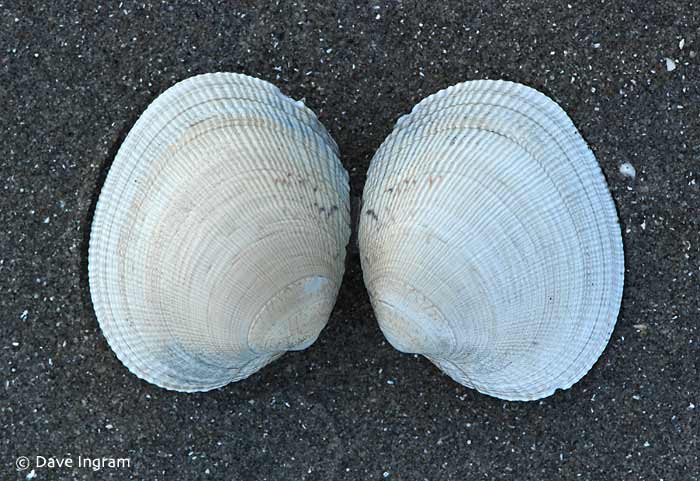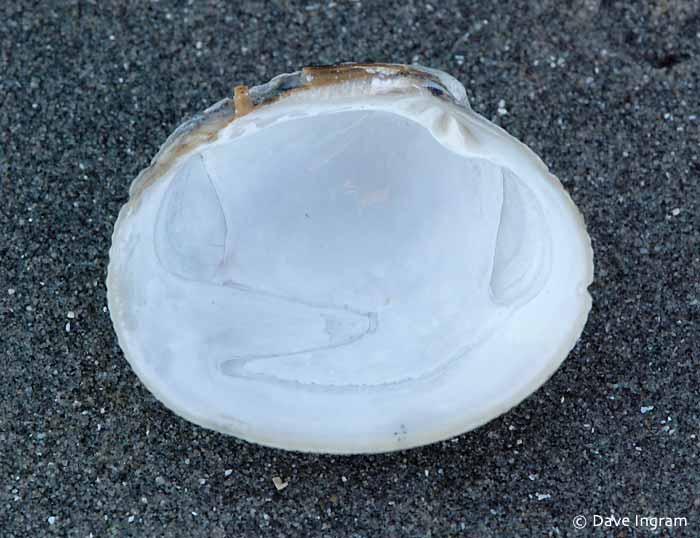I’m always on the lookout for shells of all sorts when I’m out walking the beach. I don’t collect them but simply enjoy picking them up, taking a closer look at them and then returning them to the beach for someone else to find. After all, shells taken home usually end up in shoe boxes tucked onto the top shelf of a closet somewhere. Or if they’re on display they always need dusting. Better to leave the Pacific littlenecks and other shells on the beach.

Point Holmes in Comox, BC is an excellent place for beach exploration. At low tide there is a perfect mix of both cobblestone habitat and sandy beach habitat which results in a wide variety of marine life. Throw in a few large boulders and you’ve got the potential to find Purple Seastars (Pisaster ochraceus) on a good low tide. At other times of the year I’ve found over a dozen Monterey Sea Lemons (Doris monteryensis) in the tide pools at Point Holmes.
Comparing Pacific Littlenecks with Japanese Littlenecks
In addition to the Wrinkled Dogwhelks, Pink-tipped Anemones, and Red Rock Crabs that I found at Point Holmes on my last afternoon on the beach I also found the shell of a native Pacific Littleneck (Protothaca staminea). Since finding and photographing the non-native Japanese Littleneck (Venerupis philippinarum) on the mudflats of Comox Bay I’ve been searching for the somewhat similar looking Pacific Littleneck in order to compare the two.

Shape Differences of the Shells
A quick look at the upper surface of both of these Littleneck clams is sometimes enough to identify them correctly. The Pacific Littleneck is rounder in shape than the Japanese Littleneck and mature specimens lack the patterning that is characteristic of the Japanese Littleneck. Keep in mind that immature Pacific Littlenecks often have patterned shells so assuming that a patterned shell is a Japanese Littleneck can be a mistake. Mature Pacific Littlenecks have an outer shell surface that is typically white to brown in colour with a lattice like structure (radial lines crossing the comarginal growth lines form a grid). Both of these species grow to around 7.5 cm in length.
Differences of the Inner Shells
Examining the interior of the shell is probably a more reliable way to separate these two littlenecks. The Pacific Littleneck lacks the purple staining that is usually visible in the inner shell of the Japanese Littleneck. Older Japanese Littleneck shells often lack the purple colour or have very faint colouring as the shells are worn by wave action. Feeling the margin, or edge, of the shell is also a good way to identify the Pacific Littleneck. A close look at the margin reveals fine “teeth” that are easily felt with a finger. The edge of a Japanese Littleneck shell is smooth to the touch.


Live Pacific Littlenecks are generally about 10 cm deep in gravel or sand/mud substrate. They are in the mid-intertidal zone, usually farther out than the Japanese Littleneck. Pacific littlenecks are a fast growing species of clam and live between 8 and 14 years. Both Pacific and Japanese Littlenecks are harvested commercially and make good steamer clams and ingredients in clam chowder. If you’re planning to eat Pacific Littlenecks be sure to check with the Department of Fisheries and Oceans for regulations and area closures.
Recommended Reading:
- Marine Life in Whatcom County – nice overview of both species of littlenecks including their ecology and lifecycle.
- Rick Harbo’s Shells and Shellfish of the Pacific Northwest
